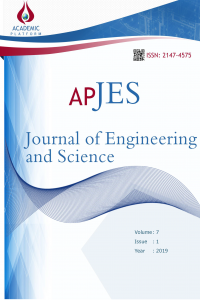Abstract
In this study,
the performance of Nakagami distribution which is previously not used in the
model of siesmic data is compared with known Generalized extreme value, Gumbel,
Weibull distributions. The comparison criterion is the coefficient of
determination and root mean square error. The siesmic magnitude data are
analyzed separately and maximum siesmic magnitudes are obtained for each year
and also block maxima (annual maximums) data set is determined. Considering the
data obtained in the short periods with extreme value theory in the study,
long-term probability of an earthquake has been obtained. Parameter estimations
of the distributions fitted to the siesmic data and the variance-covariance
matrices of these parameter estimates were determined. According to the coefficient
of determination and root mean square error, it is determined that Nakagami
distribution is also as successful as other known distributions in the
modelling of siesmic data. On the other hand; the fitting to the observed
siesmic data of the Gumbel distribution is revealed and return levels based on
this distribution is estimated. Thus, the probability of having an earthquake
of 5.1 is determined as 10% in the next 10 years.
References
- [1] N. Duru, M. Canbay, Veri Madenciliği ile Deprem Verilerinin Analizi, Kocaeli, 2007.
- [2] L. Knopoff, Y. Kagan, “Analysis of the theory of extremes as applied to earthquake problems”, J. Geophys. Res., 82(36), 5647-5657, 1977.
- [3] T.M. Yegulalp, J.T. Kuo, “Statistical prediction of the occurence of maximum magnitude earthquakes”, Bull. Seismol. Soc. Amer., 64, 393-414, 1974.
- [4] V.F. Pisarenko, D. Sornette, M.V. Rodkin, “Distribution of maximum earthquake magnitudes in future time intervals: application to the seismicity of Japan (1923–2007)”, Earth, planets space, 62(7), 567-578, 2010.
- [5] N. Akyol, F. Palas, P. Sındırgı, “Türkiye batı Anadolu depremleri için büyüklük- frekans ilişkisinin istatistiksel analizi”, Dokuz Eylül Üniversitesi Mühendislik Fakültesi, Mühendislik Bilimleri Dergisi, 14(1), 39-54, 2012.
- [6] C. Toyganözü, Ç. Balcı, Ç, “Deprem verilerinin ekstrem değer teorisi ile istatistiksel analizi: göller bölgesi örneği”. Anadolu Üniversitesi Bilim Ve Teknoloji Dergisi A-Uygulamalı Bilimler ve Mühendislik, 15(2), 105-112, 2014.
- [7] S. Coles, An Introduction to Statistical Modeling of Extreme Values, Springer- Verlag, London, 2001.
- [8] R.A. Fisher, L.H.C. Tippett, “Limiting forms of the frequency distributions of the largest or smallest member of a sample”, Math. Proc. Camb. Phil. Soc., 24(2), 180-190, 1928.
- [9] G. Casella, R.L. Berger, Statistical Inference, 2nd ed., Duxbury Thomson Learning, USA, 2001.
- [10] Y.M. Kantar, I. Usta, “Analysis of the upper-truncated weibull distribution for wind speed”, Energ. Convers. Manag., 96:81–88, 2015.
- [11] F.G. Akgül, B. Şenoğlu, T. Arslan, “An alternative distribution to Weibull for modeling the wind speed data: Inverse Weibull distribution”, Energ. Convers. Manag., 114:234-240, 2016.
Abstract
Bu çalışmada,
deprem verilerinin modellemesinde daha önce kullanılmamış olan Nakagami
dağılımının performansı, bilinen Genelleştirilmiş uç değer değer, Gumbel,
Weibull dağılımları ile karşılaştırılmıştır. Karşılaştırma kriteri olarak
belirleme katsayısı ve hata kareler ortalamasının karekökü ele alınmıştır.
Deprem büyüklüğü verileri ayrı ayrı incelenerek her bir yıl için maksimum
deprem büyüklükleri elde edilmiş ve blok maksima (yıllık maksimumlar) veri seti
belirlenmiştir. Çalışmada uç değer teorisi ile kısa periyotlarda elde edilen
veriler göz önünde bulundurularak, uzun periyotlarda deprem olma olasılıkları
elde edilmiştir. Deprem verilerine uydurulan dağılımların parametre tahminleri
ve bu parametre tahminlerinin varyans-kovaryans matrisleri belirlenmiştir.
Belirleme katsayısı ve hata kareler ortalamasının karekökü değerlerine göre,
deprem verilerinin modellemesinde Nakagami dağılımının da bilinen diğer
dağılımlar kadar başarılı olduğu görülmüştür. Diğer yandan; Gumbel dağılımının
gözlenen deprem verilerine uyumu ortaya çıkarılarak bu dağılıma dayalı
tekrarlama seviyeleri tahmin edilmiştir. Böylece, önümüzdeki 10 yıl içinde 5.1
şiddetinde deprem olma olasılığının % 10 olduğu belirlenmiştir.
References
- [1] N. Duru, M. Canbay, Veri Madenciliği ile Deprem Verilerinin Analizi, Kocaeli, 2007.
- [2] L. Knopoff, Y. Kagan, “Analysis of the theory of extremes as applied to earthquake problems”, J. Geophys. Res., 82(36), 5647-5657, 1977.
- [3] T.M. Yegulalp, J.T. Kuo, “Statistical prediction of the occurence of maximum magnitude earthquakes”, Bull. Seismol. Soc. Amer., 64, 393-414, 1974.
- [4] V.F. Pisarenko, D. Sornette, M.V. Rodkin, “Distribution of maximum earthquake magnitudes in future time intervals: application to the seismicity of Japan (1923–2007)”, Earth, planets space, 62(7), 567-578, 2010.
- [5] N. Akyol, F. Palas, P. Sındırgı, “Türkiye batı Anadolu depremleri için büyüklük- frekans ilişkisinin istatistiksel analizi”, Dokuz Eylül Üniversitesi Mühendislik Fakültesi, Mühendislik Bilimleri Dergisi, 14(1), 39-54, 2012.
- [6] C. Toyganözü, Ç. Balcı, Ç, “Deprem verilerinin ekstrem değer teorisi ile istatistiksel analizi: göller bölgesi örneği”. Anadolu Üniversitesi Bilim Ve Teknoloji Dergisi A-Uygulamalı Bilimler ve Mühendislik, 15(2), 105-112, 2014.
- [7] S. Coles, An Introduction to Statistical Modeling of Extreme Values, Springer- Verlag, London, 2001.
- [8] R.A. Fisher, L.H.C. Tippett, “Limiting forms of the frequency distributions of the largest or smallest member of a sample”, Math. Proc. Camb. Phil. Soc., 24(2), 180-190, 1928.
- [9] G. Casella, R.L. Berger, Statistical Inference, 2nd ed., Duxbury Thomson Learning, USA, 2001.
- [10] Y.M. Kantar, I. Usta, “Analysis of the upper-truncated weibull distribution for wind speed”, Energ. Convers. Manag., 96:81–88, 2015.
- [11] F.G. Akgül, B. Şenoğlu, T. Arslan, “An alternative distribution to Weibull for modeling the wind speed data: Inverse Weibull distribution”, Energ. Convers. Manag., 114:234-240, 2016.
Details
| Primary Language | Turkish |
|---|---|
| Subjects | Engineering |
| Journal Section | Articles |
| Authors | |
| Publication Date | January 15, 2019 |
| Submission Date | March 5, 2018 |
| Published in Issue | Year 2019 Volume: 7 Issue: 1 |


